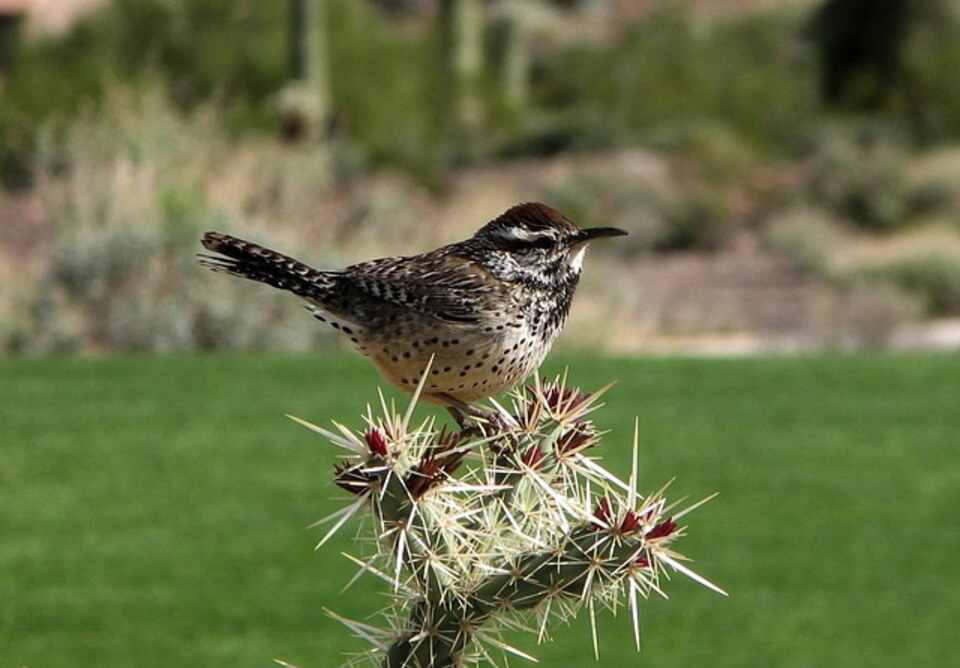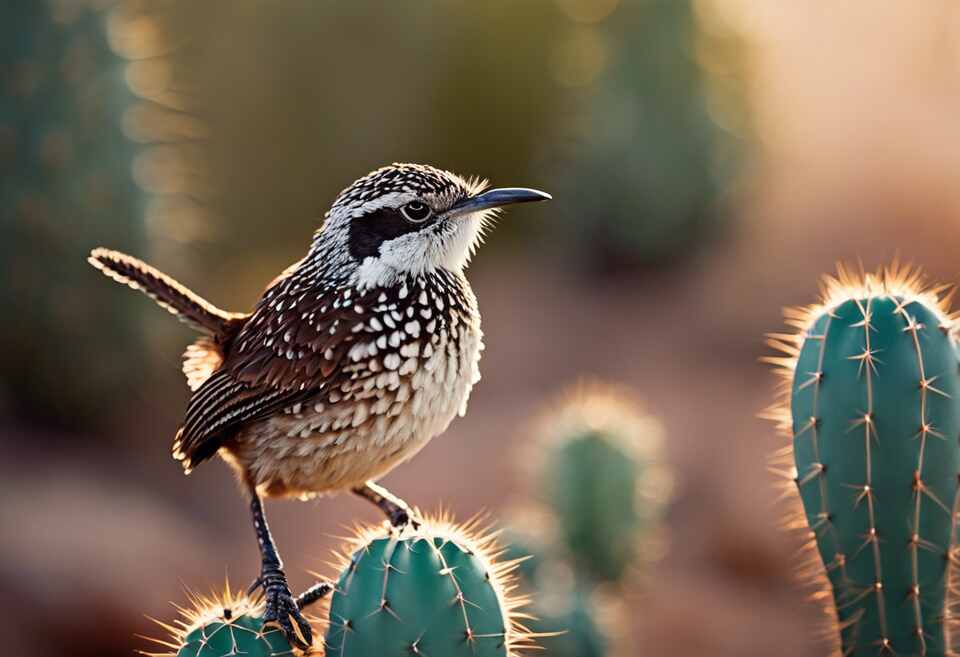The Cactus Wren, a resilient and charismatic bird, holds a special place in the hearts of Arizonans. As the official state bird of Arizona, this species has become a beloved symbol, representing the rugged beauty and unique character of the Southwestern United States.
Table of Contents
The Cactus Wren’s Selection as State Bird
The Cactus Wren became the official state bird of Arizona on March 16. 1931, thanks to the efforts of the General Federation of Women’s Clubs. At the time, many states were in the process of selecting their state birds, and the Federation lobbied state legislatures to make their choices before their biennial council meeting that year.
In Arizona, the Cactus Wren was chosen as the perfect candidate to represent the state. This bold and industrious bird was seen as a fitting symbol of the resilient and adaptive nature of Arizona’s people. The Cactus Wren is a native species closely associated with the desert environment, known for its unique appearance, intricate nests built in cacti, and its ability to thrive in the arid conditions of the state.
The Arizona state legislature agreed that the Cactus Wren embodied the spirit of the state. In 1931, when the bill was passed, the Cactus Wren was a familiar sight in many parts of Arizona, especially around Phoenix and other populated areas. Its loud voice, conspicuous nests, and lively antics made it a recognizable and beloved bird among Arizonans.
The Cactus Wren’s designation as the state bird was a testament to its status as a true “son of Arizona.” While it can be found in other parts of the Southwest and Mexico, the Cactus Wren is especially common and iconic in Arizona, making it the perfect choice to represent the state’s rugged beauty and diverse wildlife.
Discovering the Cactus Wren
The Cactus Wren: A Remarkable Avian Resident
Perched atop towering cacti or darting among the desert scrub, the Cactus Wren is a sight to behold. With its large size, distinctive brown and white plumage, and boisterous calls, this bird is hard to miss in the arid landscapes of Arizona. Thriving in the harsh desert environment, the Cactus Wren has adapted to the challenges of its surroundings, showcasing its resilience and adaptability.
| Cactus Wren Measurement | Value |
|---|---|
| Length | 7-9 inches (18-23 cm) |
| Weight | 1.1-1.5 ounces (32-43 grams) |
| Wingspan | 8-12 inches (20-30 cm) |
Nesting in the Heart of the Cacti
One of the most captivating aspects of the Cactus Wren is its unique nesting behavior. These birds build their nests within the thorny embrace of the region’s iconic prickly pear and cholla cacti. Constructing large, domed structures with a side entrance, the Cactus Wren employs the cacti’s natural defenses to protect its young from predators. This remarkable evolutionary adaptation allows the birds to thrive in an environment where many other species would struggle.
The Cactus Wren’s Diverse Dietary Habits
As an omnivorous bird, the Cactus Wren has a varied diet that reflects the diverse resources available in the desert ecosystem. From insects and spiders to small lizards and seeds, the Cactus Wren’s menu is a testament to its adaptability. This feeding flexibility allows the bird to capitalize on the seasonal fluctuations of its food sources, ensuring its survival in the face of the region’s harsh climatic conditions.
Vocalizations and Territorial Behavior
The Cactus Wren is renowned for its loud and distinctive vocalizations, which echo across the desert landscape. Its harsh, grating calls have been described as a “chuck-chuck-chuck-churr,” serving as a means of communication and territorial defense. These birds are highly territorial, aggressively protecting their nesting sites and foraging areas from intruders, both of their own species and other desert dwellers.
Conservation Efforts and Cultural Significance
Despite its resilience, the Cactus Wren faces various environmental threats, including habitat loss and degradation due to human development and the impacts of climate change. Conservation efforts, such as preserving and restoring desert ecosystems, are crucial to ensuring the long-term survival of this iconic bird. Beyond its ecological importance, the Cactus Wren holds significant cultural significance for the people of Arizona, appearing in art, literature, and local traditions, further solidifying its status as a revered symbol of the state.
Exploring the Cactus Wren’s Wonders
Encountering the Cactus Wren in its natural habitat is a truly awe-inspiring experience. Witnessing the bird’s agile movements, hearing its distinctive calls, and observing its intricate nesting behaviors allows visitors to gain a deeper appreciation for the unique adaptations and resilience of this desert dweller. As Arizona’s state bird, the Cactus Wren serves as a testament to the remarkable diversity and beauty of the Southwestern United States, inviting visitors and residents alike to explore and cherish the wonders of the desert ecosystem.

Unique Habits of the Cactus Wren
The Cactus Wren, scientifically known as Campylorhynchus brunneicapillus, is a truly remarkable bird species that calls the arid landscapes of the Sonoran Desert in Arizona its home. As the state bird of Arizona, this charismatic creature has captured the hearts and imaginations of nature enthusiasts, bird watchers, and outdoor enthusiasts alike.
Unraveling the Unique Habits of the Cactus Wren
The Cactus Wren showcases a distinctive feature with a white eye stripe stretching from behind each eye to near its upper back. This robust bird is characterized by its rich, brown plumage adorned with white spots and bars. Its long, sturdy beak is finely adapted for maneuvering through the thorny cacti that dominate its habitat. One of the bird’s most captivating features is its diverse vocal repertoire, encompassing a wide array of loud, harsh calls alongside more melodious trills and warbles.
These birds are renowned for their impressive nest-building abilities, constructing large, domed structures with a side entrance. The nests, often located high up in the branches of cacti or other desert vegetation, provide ample protection from predators and the harsh elements of the Sonoran Desert. The Cactus Wren’s dedication to its nest is remarkable, as it will fiercely defend its home against intruders, using its powerful beak and talons to deter any perceived threats.
Adapting to the Sonoran Desert Habitat
The Cactus Wren’s ability to thrive in the arid, harsh conditions of the Sonoran Desert is a testament to its remarkable adaptations. These birds have evolved mechanisms to cope with the intense heat and scarcity of water that characterize their environment. Their thick, insulating plumage helps them regulate their body temperature, while their efficient water-conserving abilities allow them to survive extended periods without direct access to water sources.
One of the Cactus Wren’s most fascinating adaptations is its reliance on the ubiquitous cacti that dominate the Sonoran Desert. These birds not only use the cacti as nesting sites but also as a source of food, foraging for insects, spiders, and other small prey that take refuge within the plants’ spiny structures. The Cactus Wren’s dexterous beak and agile movements enable it to navigate the cacti with ease, extracting sustenance from the most seemingly inhospitable of environments.
The Cactus Wren’s Role in the Sonoran Desert Ecosystem
The Cactus Wren’s significance extends beyond its captivating appearance and unique behaviors; it also plays a vital role in the intricate web of life that characterizes the Sonoran Desert ecosystem. As a skilled predator, the Cactus Wren helps to control the populations of insects and other small invertebrates, contributing to the overall balance of the desert’s delicate food chain.
Moreover, the Cactus Wren’s nest-building habits have a profound impact on the desert landscape. The large, durable nests they construct provide valuable shelter and nesting sites for a variety of other desert-dwelling species, including small mammals, reptiles, and even other bird species. This keystone role in the ecosystem highlights the Cactus Wren’s importance as a vital component of the Sonoran Desert’s fragile and interconnected natural environment.
Appreciating the Cactus Wren’s Conservation Significance
Despite its status as the state bird of Arizona, the Cactus Wren faces various threats to its long-term survival. Habitat loss and fragmentation due to urban development, as well as the impact of invasive species and climate change, pose significant challenges to the species’ continued presence in the Sonoran Desert.
Conservation efforts aimed at protecting the Cactus Wren and its habitat are crucial to ensuring the continued resilience of this iconic bird. By supporting local and national initiatives that promote the preservation of the Sonoran Desert’s natural landscapes, nature enthusiasts and bird lovers can play a vital role in safeguarding the future of the Cactus Wren and the delicate ecosystem it calls home.
Through our collective appreciation and stewardship of the Cactus Wren and its remarkable adaptations, we can ensure that this avian treasure continues to captivate and inspire generations to come, serving as a symbol of the Sonoran Desert’s unique and irreplaceable natural wonders.

Conclusion
The cactus wren is a true icon of the Sonoran Desert, a hardy and resilient bird that has captured the hearts of Arizona’s residents and nature enthusiasts alike. Its distinctive calls, intricate nesting habits, and adaptations to the harsh desert environment make it a fascinating subject of study and appreciation.
As the largest wren species in North America, the cactus wren is a true marvel of nature. Its ability to thrive in the unforgiving landscape of the Sonoran Desert is a testament to the incredible adaptations that have evolved over centuries. From its robust beak, capable of navigating the spines of cactus plants, to its insulative plumage that protects it from the scorching sun, the cactus wren is uniquely equipped to survive and thrive in its arid homeland.
One of the most captivating aspects of the cactus wren is its nesting behavior. These birds construct intricate, dome-shaped nests made from twigs, grasses, and other desert materials, often incorporating the protection of a cactus or other thorny plant. The nests are strategically placed to provide shelter from the elements and deter predators, showcasing the cactus wren’s remarkable intelligence and adaptability.
Another fascinating characteristic of the cactus wren is its complex vocalization. These birds are known for their loud, distinctive calls, which can be heard echoing across the desert landscape. Their repertoire includes a range of chirps, trills, and guttural sounds that serve to communicate with mates, defend territories, and alert other birds to potential threats. This vocal prowess not only makes the cactus wren a delight to observe but also plays a crucial role in its survival and social interactions.
Beyond their physical and behavioral adaptations, cactus wrens play a vital role in the delicate ecosystem of the Sonoran Desert. As omnivores, they help to maintain the balance of the desert’s food web, feeding on a variety of insects, spiders, and even small lizards and rodents. Additionally, their nests provide shelter and nesting sites for other desert-dwelling species, contributing to the overall biodiversity of the region.
Unfortunately, the cactus wren, like many other desert-adapted species, faces ongoing threats to its survival. Habitat loss and fragmentation due to human development, as well as the impacts of climate change, pose significant challenges to the long-term viability of these remarkable birds. Conservation efforts, including the preservation of native desert habitats and the promotion of sustainable development practices, are crucial to ensuring that the cactus wren continues to be a cherished part of Arizona’s natural heritage.
As we dive deeper into the fascinating world of the cactus wren, we are reminded of the importance of preserving and protecting the unique and irreplaceable ecosystems that these birds call home. By learning about the cactus wren’s remarkable adaptations, we can gain a greater appreciation for the resilience and beauty of the Sonoran Desert, and be inspired to take action to safeguard this iconic state bird for generations to come.



